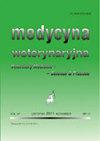Effect of almond (Prunus dulcis) hull addition to corn silage on silage quality, silage fermentation properties and in vitro digestibility
IF 0.4
4区 农林科学
Q4 VETERINARY SCIENCES
Medycyna Weterynaryjna-Veterinary Medicine-Science and Practice
Pub Date : 2023-01-01
DOI:10.21521/mw.6784
引用次数: 0
Abstract
This study aimed to determine the effects of the addition of almond hull to corn silage on silage quality, fermentation properties and in vitro organic matter digestion (IVOMD). While corn silage without additives constituted the control group in the study, silages with almond hull added at the levels of 0.5%, 1%, 1.5%, 2% and 2.5% formed the experimental groups.The addition of almond hull caused an increase in the IVOMD and metabolizable energy (ME) values of the silages compared to the control group. For all the experimental groups, the methane (CH4) values of the silages were lower than the values of the control group. The silage pH range of all silage groups was in the range of 3.62-3.70. The lactic acid (LA) and acetic acid (AA) values of the silages, on the other hand, were higher in all experimental groups compared with the values of the control group, and the highest values were observed in the group with the 1% almond hull addition. No propionic acid (PA), butyric acid (BA), or mold was detected in any of the silage groups. The yeast values, on the other hand, were lower in all silages that contained added almond hulls than the in the control group. The amount of CO2 produced in the silage groups decreased in parallel with the increase in almond hull. This study will enable more use and evaluation of almond hulls in animal nutrition due to its positive effect on fermentation.玉米青贮中添加杏仁壳对青贮品质、青贮发酵特性及体外消化率的影响
本试验旨在研究玉米青贮饲料中添加杏仁壳对青贮品质、发酵特性和体外有机物消化(IVOMD)的影响。不添加添加剂的玉米青贮为对照组,杏仁壳添加量分别为0.5%、1%、1.5%、2%和2.5%的青贮为试验组。与对照组相比,杏仁壳的添加使青贮饲料的IVOMD和代谢能(ME)值增加。各试验组青贮饲料的甲烷(CH4)值均低于对照组。各青贮组青贮pH值范围为3.62 ~ 3.70。与对照组相比,各试验组青贮料的乳酸(LA)和乙酸(AA)值均较高,以添加1%杏仁壳组最高。各组青贮饲料均未检测到丙酸(PA)、丁酸(BA)或霉菌。另一方面,添加杏仁壳的青贮饲料中的酵母值低于对照组。青贮组的CO2产生量随着杏仁壳的增加而减少。本研究将为杏仁果壳在动物营养方面的进一步利用和评价提供依据。
本文章由计算机程序翻译,如有差异,请以英文原文为准。
求助全文
约1分钟内获得全文
求助全文
来源期刊

Medycyna Weterynaryjna-Veterinary Medicine-Science and Practice
VETERINARY SCIENCES-
CiteScore
0.80
自引率
0.00%
发文量
73
审稿时长
4-8 weeks
期刊介绍:
"Medycyna Weterynaryjna" publishes various types of articles which are grouped in the following editorial categories: reviews, original studies, scientific and professional problems, the history of veterinary medicine, posthumous memoirs, as well as chronicles that briefly relate scientific advances and developments in the veterinary profession and medicine. The most important are the first two categories, which are published with short summaries in English. Moreover, from 2001 the editors of "Medycyna Weterynaryjna", bearing in mind market demands, has also started publishing entire works in English. Since 2008 the periodical has appeared in an electronic version. The following are available in this version: summaries of studies published from 1999 to 2005, full versions of all the studies published in the years 2006-2011 (in pdf files), and full versions of the English studies published in the current year (pdf). Only summaries of the remaining studies from the current year are available. In accordance with the principles accepted by the editors, the full versions of these texts will not be made available until next year.
All articles are evaluated twice by leading Polish scientists and professionals before they are considered for publication. For years now "Medycyna Weterynaryjna" has maintained a high standard thanks to this system. The review articles are actually succinct monographs dealing with specific scientific and professional problems that are based on the most recent findings. Original works have a particular value, since they present research carried out in Polish and international scientific centers.
 求助内容:
求助内容: 应助结果提醒方式:
应助结果提醒方式:


